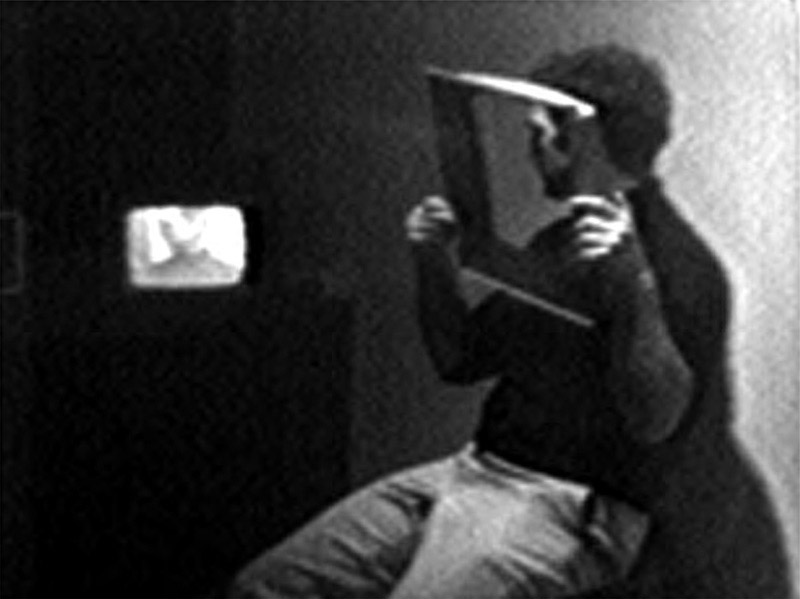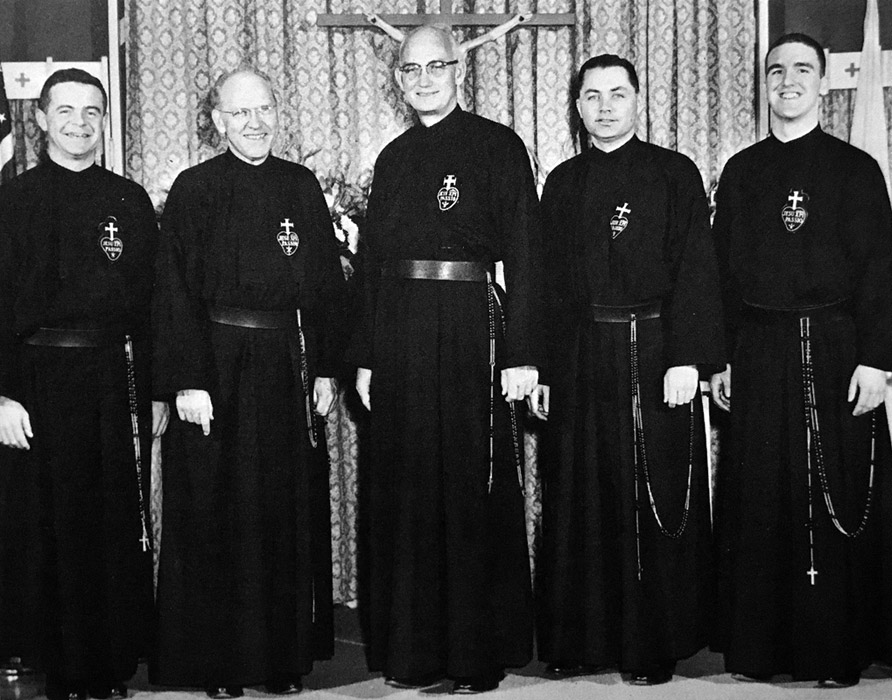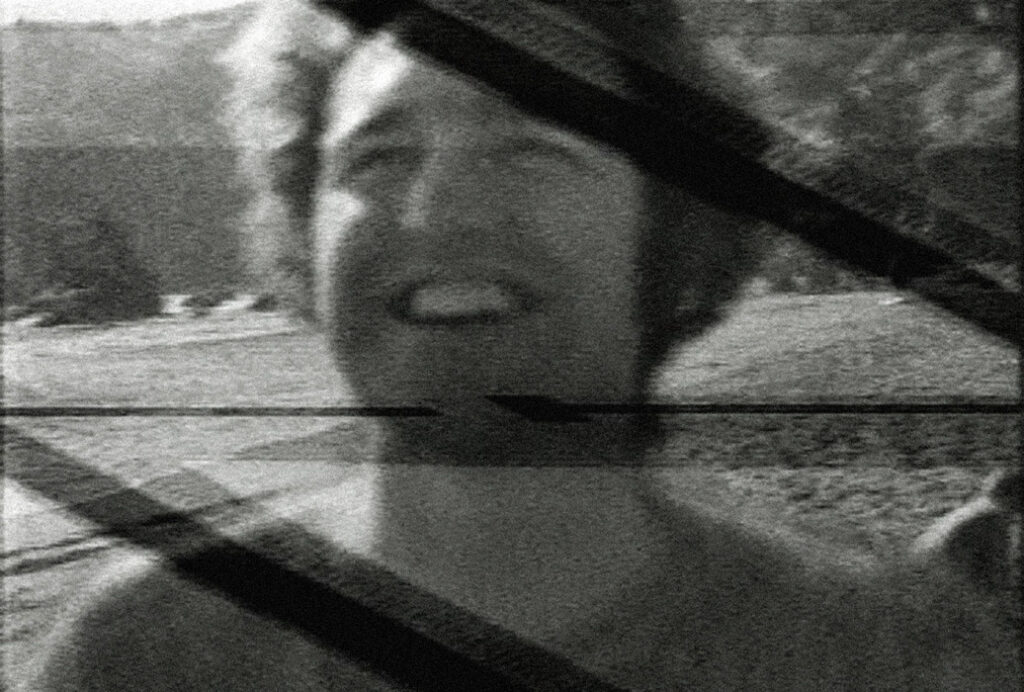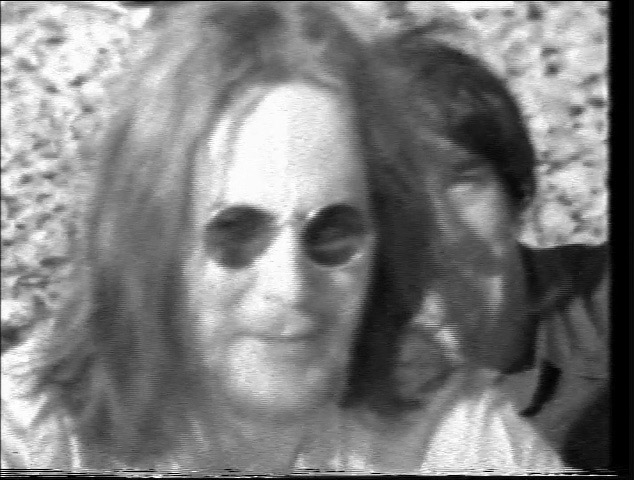
video still from documentation by Ira Schneider
In May 19691, a video installation entitled Everyman’s Moebius Strip appeared at the Howard Wise Gallery show TV as a Creative Medium in New York. When an individual entered a curtained booth, they found a video camera, a blank monitor, and an audio recording prompting participation. “React to the following people,” spoke the recording. “Nixon, your mother, Eldridge Cleaver, Teddy Kennedy, you.… For the next ten seconds do what you want.… Now, let your face be sad.… Turn away from the camera.… Now turn back.… Press the stop button.… Thank you.” After two minutes of this guidance, an attendant played a videotape of the viewer’s face back for them. Like its topological namesake, explained the artist, Everyman’s Moebius Strip “is used to take in our outside,” providing the viewer “one continuous (sur)face with nothing to hide.” Since each recording taped over the previous one, each participant received a unique, private experience of communing with the self2.
Lest the resemblance of this booth of self-revelation to a Catholic confessional be too obscure, in 1970 the installation’s creator, Paul Ryan, published a description of another installation which would also prompt a participant and then show them a tape of their reactions. Ego Me Absolvo was unrealized, but it would have been an “ordinary single penitent confessional set up against the wall of the gallery,” wrote Ryan. “Penitent (gallery goer) goes into the confessional and kneels. He flips on an audiotrack which guides him through an appropriate confession. While he confesses, his face is videotaped. When finished making his confession, he goes round where the priest sits and watches the replay of his own confession3.”
The experimental videographers of the 1960s and 1970s drew on a variety of resources, including video technology itself and discourses about the futures of media and humanity, in their efforts to create new aesthetic and social experiences. (Collopy, 2015) For Ryan, these resources included Catholic spiritual practices. Over the course of his artistic and intellectual career, Ryan would continue to find insight and inspiration not so much in Catholic theology as in the lived practices of Catholicism, which he treated not as authoritative structures for his life but as a set of prototypes for his own aesthetic, psychological, and ecological experiments.
From Monk to McLuhanite

Paul Ryan had become a Roman Catholic monk, a member of the Passionist order, in 1960 at the age of 17. He left five years later, recognizing that the order hadn’t changed as he hoped during the era of the Second Vatican Council and complaining to his superior that he found the monastery intellectually, communally, and liturgically unsatisfying5. In his new life as a layperson in New York, Ryan protested the Vietnam War and then, frustrated that “marches seemed to have so little effect,” turned to writing fiction. “I locked myself up in a garret on the Lower East Side and pounded a typewriter,” he later wrote. “The war went on. Midway through the summer of 1966, I tuned in to WBAI’s coverage of the International Writers’ Conference. The speaker was saying, ‘Of course in this electronic age of computers, satellites, radio, and television, the writer can no longer be someone who sits in his garret pounding a typewriter.’” This was media theorist Marshall McLuhan, and Ryan became a convert to his new doctrine. (Ryan, 1993, p. 11-12)
In McLuhan’s books, Ryan found a theory in which societies based on electronic media recapitulated the attitudes and social order of an earlier age of orality. (McLuhan, 1994, p. 50) As Tina Edan and Jonathan Sterne observe, both the devoutly Catholic McLuhan and his Jesuit student Walter Ong believed that the dominance of literacy since the development of print undermined Christian community and spirituality, and that the “secondary orality” of electronic media offered an opportunity for revival6. Inspired by McLuhanism, Ryan “developed a strategy,” he wrote. “I could go from the oral monastic culture to the electric. Skip the gutenburg [sic] galaxy.… Get my hands on the new media.7” In 1967, then, Ryan found a job as one of McLuhan’s research assistants when Fordham University, a Jesuit institution in the Bronx, persuaded McLuhan to visit for a year away from his usual professorship at the University of Toronto. At Fordham, Ryan began experimenting with two Sony video recorders donated by an admirer of McLuhan. (Collopy, 2015)
Infolding the Self

With this technology, Ryan developed techniques for building the insight and community he had sought in the monastery, coming to believe in the process that videotape was fundamentally a tool for psychological reflection and self-exploration as much as for communication. “VT,” wrote Ryan, “is not TV. If anything, it’s TV flipped on itself. Television… has to do with transmitting information over distance. Videotape has to do with infolding information. Instant replay offers a living feedback.” (Ryan, 1968, p. 38) This was the theory embodied by Everyman’s Moebius Strip.

Ryan loaned one of Fordham’s video recorders to painter Frank Gillette, who was taping a documentary in New York’s East Village when he met Victor Gioscia, a philosopher and therapist who—like a small network of other therapists at the time—was also using video. The two began collaborating. “I experimented,” explained Gillette, “with the effects of videotape on kids with bad trips—15 to 19 year olds—burnt-out acid cases—let them use the cameras on me, themselves, as a means of expression10.”
Ryan and Gioscia also collaborated, recording a conversation, playing it back in slow motion, and each imitating the other’s movements in order to better understand each other. “When I woke up the next morning,” recalled Ryan, “I felt like I was wearing his body.” (Ryan, 1973, p. 39) Ryan rejected psychotherapy as a modality, though, describing himself as “one of those people… who has been raised Catholic and doesn’t like the whole notion of therapy.11” A decade later, he heard Michel Foucault lecture on “Sexuality and Solitude” at New York University and wrote Foucault a letter, describing his efforts to develop a topological model of the psychological relations inherent in video. “Perhaps such mapping relates,” wrote Ryan, “to what you are calling the ‘technology of self.12’”
Ryan and the video therapists had inherited two of the great sacraments of incitement to discourse, confession and psychoanalysis. (Foucault, 1990, p. 18, 30) Both were indeed, in Foucault’s terminology, technologies of the self, methods which “permit individuals to effect by their own means or with the help of others a certain number of operations on their own bodies and souls, thoughts, conduct, and way of being, so as to transform themselves in order to attain a certain state of happiness, purity, wisdom, perfection, or immortality.” (Foucault, 1988, p. 18) While Ryan shared with Gioscia and other video therapists a belief that the incitement to mediated discourse with the self could bring about self-understanding, he adopted the venerable Catholic mode of confession rather than the modern mode of psychiatric examination.
Media Ecologies
In the 1970s, Ryan became interested in using video to produce experiences of community and ecology as well of the self. In these domains, too, he continued to draw on Catholic practices. In 1973, Ryan founded Earthscore, an “intentional community of videomakers” near New Paltz, New York. In composing a set of rules for his new community, he incorporated rituals such as video wakes for the dead and drew on the Rule of Saint Benedict that organizes Benedictine monasteries. Ryan later described Earthscore as “a non-celibate, aesthetic order capable of interpreting ecological systems with video that would be as sturdy and long lasting as the celibate, ascetic orders of the monastic tradition13.”
In its ideal form, Earthscore would have brought together 36 members working and living in “self balancing groups of three,” who would “decode the ecology and feed it back to the local community over cable TV.” Since Ryan was only able to recruit two other members, Earthscore consisted instead of a single triad of three men who produced tapes documenting ecological systems and their own triadic interactions. Like most intentional communities of the 1970s, Earthscore was short-lived, dissolving in 197614.
Excerpts from Triadic Tapes (1975), Nature in NYC (1989), and Bronx Falls (1988) by Paul Ryan
Ryan continued making video about ecology and triadic relations, though. In the 1980s, he also became involved in Christian institutions again as the co-director of the Gaia Institute at the Cathedral of Saint John the Divine, an Episcopalian church in New York. In the process of exploring the cultural implications of James Lovelock’s Gaia Hypothesis, Ryan preached on acid rain and screened his ecological video. (Ryan, 1993, p. 253, 260) He also wrote on the suffering and death of Jesus as a metaphor for environmental harm, and on how a television “ecochannel” like that he has earlier proposed as part of Earthscore could resolve the ambiguous guidance of such a metaphor in the development of a new ecological ethic. (Ryan, 1993, p. 262-281) Throughout his adult life, then, Paul Ryan used video, McLuhanism, and idiosyncratic variations on Catholic practices to produce the spirituality and community that had led him as a teenager to monastic life.
Notes
[1] Still frame from Paul Ryan, interview by Felicity D. Scott and Mark Wasiuta, “Cybernetic Guerrilla Warfare Revisited: From Klein Worms to Relational Circuits,” Grey Room, no. 44 (Summer 2011): 114.
[2] Paul Ryan, interview by Willoughby Sharp, “Paul Ryan: Video Pioneer,” Video 81 2, no. 1 (1981): 14; Jud Yalkut, “TV as a Creative Medium,” Arts Magazine, September/October 1969, 19; Howard Wise Gallery, TV as a Creative Medium(New York: Howard Wise Gallery, 1969).
[3] Rose Art Museum, Vision & Television: An Exhibition of the Poses Institute of Fine Arts (Waltham, Mass.: Rose Art Museum, 1970).
[4] Photograph from Michael Shamberg and Raindance Corporation, Guerrilla Television (New York: Holt, Rinehart and Winston, 1971), section II, p. 4.
[5] Ryan, interview by Sharp, “Paul Ryan,” 15–16; Paul S. Ryan to Father Provincial, February 9, 1965, Passionists file, Paul Ryan Papers, Archives of American Art, Smithsonian Institution.
[6] Tina Edan, “St. Marshall, Mass and the Media: Catholicism, Media Theory and Marshall McLuhan” (master’s thesis, Concordia University, 2003), 52–55; Jonathan Sterne, “The Theology of Sound: A Critique of Orality,” Canadian Journal of Communication 36 (2011): 208, 218–219.
[7] [Paul Ryan], introduction to “Video and Cybernetic Guerrilla Warfare” (c. 1971), Writings series, Ryan Papers, p. 3.
[8] Still frame from Tegan Mcauley, “Post Digital,” Portrait, no. 48 (2015).
[9] Still frame from Paul Ryan, Tender is the Tape (1970), video.
[10] Davidson Gigliotti, “A Brief History of RainDance” (2003); Frank Gillette and Ira Schneider, interview by Jud Yalkut, “Frank Gillette and Ira Schneider: Parts I and II of an Interview,” Radical Software 1, no. 1 (Summer 1970): 9, reprinted from The East Village Other, July 30, 1969. On video therapy, see Collopy, “The Revolution Will Be Videotaped,” especially 170–193.
[11] Ryan, interview by Scott and Wasiuta, “Cybernetic Guerrilla Warfare Revisited,” 117.
[12] Paul Ryan to Michel Foucault, November 25, 1980, Michel Foucault file, Ryan Papers.
[13] Ryan, Video Mind, Earth Mind, 54–55, 70; Paul Ryan, “Video Journey through Utopia” (2001), Earthscore, originally published in Afterimage 27, no. 3 (1999), p. 5.
[14] Ryan, Video Mind, Earth Mind, 54–55; Ryan, “Video Journey through Utopia,” 5; Ryan, interview by Sharp, “Paul Ryan,” 14. Although Ryan drew his understandings of triadic relationships primarily from cybernetician Warren McCulloch and philosopher Charles Sanders Pierce, he also acknowledged the influence of his experience meditating on the Trinity as a monk. Paul Ryan, “Cybernetic Guerrilla Warfare,” Radical Software 1, no. 3 (Spring 1971): 1; Paul Ryan, “The Earthscore Notational System for Orchestrating Perceptual Consensus about the Natural World,” Leonardo 24, no. 4 (1991): 457; Ryan, Video Mind, Earth Mind, 254.
Bibliographie
– Collopy, Peter Sachs, «The Revolution Will Be Videotaped: Making a Technology of Consciousness in the Long 1960s», thèse de doctorat, Département de philosophie, Université de Pennsylvanie, 2015, 348 f.
– Foucault, Michel, The History of Sexuality: An Introduction, trad. Robert Hurley, New York, Vintage Books, 1990, 168 p.
– Foucault, Michel, «Technologies of the Self», dans Luther H. Martin, Hugh Gutman, and Patrick H. Hutton, Technologies of the Self: A Seminar with Michel Foucault, Amherst, University of Massachusetts Press, 1988, 176 p.
– McLuhan, Marshall, Understanding Media: The Extensions of Man, Cambridge, MIT Press, 1994, 392 p.
– Ryan, Paul, Video Mind, Earth Mind: Art, Communications, and Ecology, New York, Peter Lang, 1993, 437 p.
– Ryan, Paul, «Videotape: Thinking about a Medium», Educators Guide to Media & Methods, December 1968.
– Ryan, Paul, Birth and Death and Cybernation: Cybernetics of the Sacred, New York, Gordon and Breach, 1973, 175 p.
